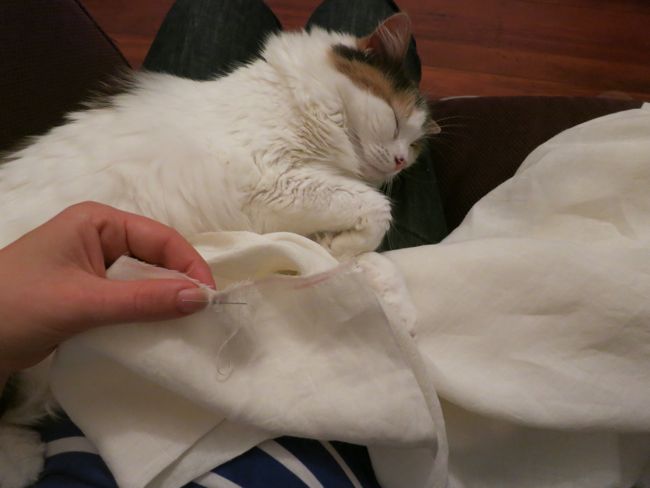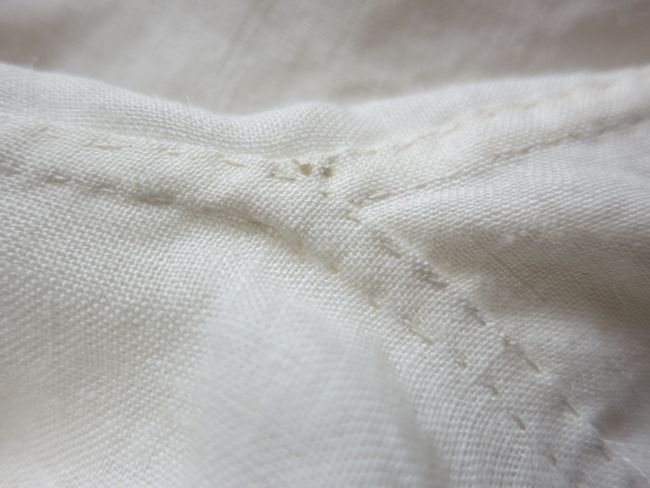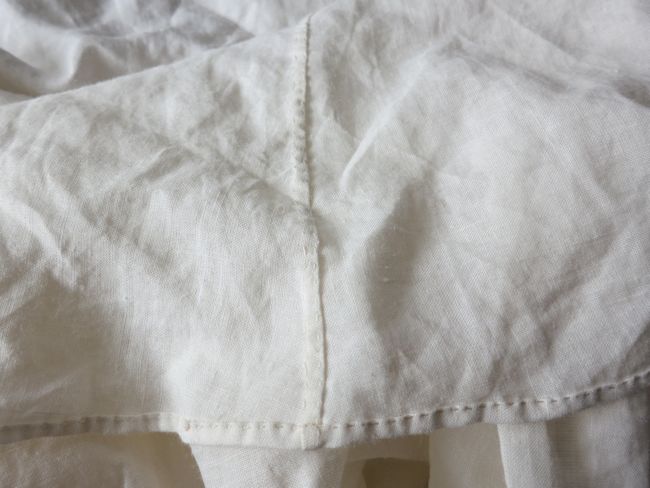When I made my nettle shift/smock I wanted my construction to be reasonably historically accurate, but in researching 14th century smocks* I discovered that there are so few visual images of smocks of that period, so few extent garments (none of which remotely match the visual record) and so few written mentions that we really don’t know how 14th century smocks were made. The best guesses are based on extrapolating backwards from extent garments from later periods, and matching that up to the few period depictions and the single extent (sorta, it’s been missing since WWII so all we have is a black and white photograph) example (which doesn’t look at all like period depictions) and known sewing techniques from other garments.
Many reproduction medieval smocks/shifts/chemises are constructed like 16th-18th century shifts – a series of rectangles and triangles, with gussets under the arm, and side gores to allow the shift to flare. It’s a frugal, practical and durable construction method. However the single extent (sorta) 14th century smock, is side gore-less (and while there is a 13th century shift that does have side gores, both it and the 14th century example are sleeveless – very helpful). So other patterns are certainly plausible.
In addition to wanting my shift to be at least plausible, I also needed it to be as quick as possible. I’m time poor at the moment. So I opted for a more-or-less midpoint between the two patterns: a simple one piece T shape with flared sides.
The T-shape is cut to the full width of the fabric, so I didn’t have to hem the sleeves, because they end on the selvedge edges. The flared sides are slightly curved, because both extent medieval shifts have curved sides. The only extra pieces are square gussets to set under the arms.
As you can see, cutting the garment this way leaves a scrap of triangular fabric cut from under the arm, effectively ‘wasting’ fabric, which makes it slightly less historically plausible, as fabric was so valuable it would have been used as frugally as possible.
With the pattern sussed, I sewed.
Felicity, as per our cat-owner sewing agreement, helped:
The smock is sewn with silk thread (would linen be more accurate? Likely, but since I was using ramie/nettle instead of linen I felt a little thread jiggery pokery was not really the biggest issue) with basic running backstitches. The neck edge and hem are simply turned twice and stitched down with the same running backstitches.
As I began setting in the sleeve gussets the problem with my pattern became immediately obvious. Without a shoulder seam, there are stress points where the corner of the gusset meets the shift are going to be quite vulnerable to tearing.
A shoulder seam would have provided extra strength to this point, and made it easier to set the gusset, and would also have let me cut the sleeves alongside the smock, saving fabric, and giving me full-length sleeves, instead of 3/4 length sleeves.
I could have skipped a gusset altogether, but that would have reduced my arm range in the smock, and it would still have been very vulnerable to underarm tears – perhaps even more so than with the gusset. I suppose I could have cut across the underarm at an angle, as if the gusset was there.
In order to re-inforce the gusset, and stop the ramie from fraying (it frays badly) I flat felled all the seams, just as you would with an 18th century shift, though I haven’t been able to find information on whether that was done with medieval smocks (it’s seen on some examples of medieval wool garments, and makes sense with linen, so I’m guessing it’s more likely than not).
Many of you asked about ramie/nettle fabric – I’ll be doing a full terminology post, but here is a close up of the fabric to try to show you the texture as much as possible. You can clearly see that it is fuzzier and more fibre-y than linen:
Unlike linen, ramie doesn’t seem to soften press and meld together as you sew it. It’s much ‘drier’ and crisper, and I suspect will not wear as well. It’s also itchier, so I’m glad that I didn’t put as much effort into this smock as I would one of proper handkerchief linen.
Ramie is a lot like linen though, especially in that it finger-presses beautifully. Sewing all those felled seams was a breeze, and turning and sewing the hem and neck was also easy.
I did wear the shift to climb trees and scramble up a steep hill and carry things around, and it held up very well (without even a dress over it to protect it), so the sleeve gussets aren’t as fragile as I thought they might be.
However, having made this shift, I don’t think the construction is the most plausible method for medieval shifts, simply because it isn’t the best use of fabric (though I’d have to do more research on the width of medieval linens to find out what layout would be most likely), and because it leaves weak points in the garment, and I can’t imagine even the richest of medieval queens being thrilled about a shift that ripped out under the arms. In the future, I will at least be constructing my shifts with separate sleeves and shoulder seams.
*translation: reading all my historical costuming books that mention medieval clothes at all, all the main medieval blogs, checking all my pinterest links, and finding almost nothing, and finally just polling the brilliant minds of the Historical Sew Fortnightly facebook group for information














I now see what you mean about the construction of your lovely shift, Whatever the shape truly was of late medieval shifts, the “t-piece” construction you used probably wasn’t the way they were made.
There are a few other early (including another 13th century one) but they are male not female. One of the better known is attributed to a 13th century French king, Louis. Heather Rose Jones wrote a good web article that mentions the others; it can be found here: http://heatherrosejones.com/stlouisshirt/
I agree that there is little information from extant clothing to be had for 14th century underwear–that’s why it’s difficult to document clothing construction (and often, clothing design) for anything dating to before the 16th century. There is a book by Olga Sronkova called “Gothic Woman’s Fashion” that collects a number of images from 14th-15th century art of women’s smocks. These are all sleeveless, like the image you linked to. That makes sense to me (though whether something “makes sense” isn’t automatically proof), because in the 14th century dress sleeves began to be tightly fitted, and would be harder to put on over a long sleeved shift.
It’s also possible that there is more information available in the form of the 15th century linen clothing fragments found at Lengberg Castle in Austria–but we’re both too busy to dig into those much right now!
One more thing. There is a brief research piece on the Internet by a friend of mine about problems with the provenance of the picture of the extant shift you linked to. I’m trying to find the article but I’m having no luck; if I do, I’ll pass it on.
What an interesting and useful article! Thank you for sharing, Catherine.
Yes, I only looked at women’s undergarments, but forgot to mention that there are extent mens ones!
I find I can easily pull tight (modern) sleeves over this shift. We’ll see how it goes when I make a proper 14th c garment
I’d be really interested in the article on the provenance of the extent shift if you could find it.
Hello Dreamstress! I was wondering why you spell it “raime”. I’ve always seen it spelt “ramie”. I’ve never heard it said out loud, though… Are the two terms interchangeable?
I spell it raime because I’m a dork who got the wrong spelling stuck in my head and just kept using it! It should be ramie!
One more thing: there is limited evidence from Scandinavia during the Viking age of shifts shaped much like the one you made but with separate shoulder seams; this article is a good summary of known finds:
http://urd.priv.no/viking/serk.html
Shortly after you published your photo essay about this shift, I found an EBay vendor who is selling white ramie cloth (calls it “ramie linen”, though) for a very reasonable price. I may buy some, for one of the upcoming projects (maybe I can make that Deshaheh dress from it!), but I’m waiting on a paycheck again.
I actually read (well skimmed) that article in doing my research, but discounted it as justification for my shift, because the ones that look a bit like mine are three+ centuries earlier, and probably from a culture that had little interaction with Southern Europe.
Oooh…buy some if you can! I’d love to see what you make of it!
Is this the ramie from whaleys? Oddly enough I’ve just bought some to make my own shift. I’ll be sewing with linen thread if I can’t self sew, as I’ve found over the years that silk thread on shifts has a tendency to disintegrate during washing, presumably down to the whole modern detergents being designed to dissolve protein based stains and silk being a protein fibre thing( don’t worry, it does take a year or two of regular wear)
I’m not sure what Whaleys is, so no! I found this at a fabric fair in Wellington.
The fibres of this shift weren’t suitable for self sewing, but I don’t wash historical garments with modern detergent, so at least the silk thread won’t be a problem in that way – thanks for the tip on it though!
Thanks, Catherine, for the information. Funnily enough, I’ve been seeing a lot of ramie in catalogues recently. (Catalogues are free magazines, in my opinion) Maybe it’s coming onto the linen trend of the last season. Who knows. At any rate, it’s an interesting bookend to this article about early clothing.
It is indeed interesting, Elise! Thanks for the note that ramie seems to be getting more common; I won’t feel bad then if the vendor on EBay sells out before I can act.
Glad I could add something–thanks again for all the information you and Sue share.
I wonder, though, just for laundry’s sake, if there could be small sleeves on the shift, to catch the worst of the under arm odor, but without full sleeves that would hurt the shape of the tight long sleeves of the time. I know that despite popular imagination people did bathe during the early and high middle ages, so it would make sense that clothes were kept (relatively) clean, too. What are your thoughts?
Re: type of thread used. Early medieval garments (i.e. no later than the Viking period, say) typically use thread of the same fiber type as the fabric of the garment–wool for wool fabric, linen for linen, and silk for silk. I think that changed during the later Middle Ages, but I don’t presently recall what thread types came to be dominant.
By the way, I don’t typically match thread type to fabric in my sewing, largely because I haven’t found a wool thread fine and strong enough that I’d be willing to sew with it. I typically use linen thread on linen, and silk thread for everything else.
feoragdubh.eastkingdom.orgThere are earlier surviving tunics and I don’t consider it a stretch to construct an undergarment with the same basic seams as a tunic. http://www.feoragdubh.eastkingdom.org/GarbWorkshops.php
Thanks. I do think it is plausible-ish. There may very well have been a few examples that looked like this – but more likely there were far more that didn’t!
I think the Elizabethan smock generator is about as accurate a period construction for any smock after attached sleeves and gussets are know to exist, which is extremely early. Bottom needs to be wider than the shoulders for movement, so godets are the best way to conserve fabric to get that. As a different issue, it wouldn’t be unusual for multiple smocks to be made at once time, even if the maker/wearer was poor, since women rarely lived alone.
Lovely shift (and lovely flat felled seams — I do love proper seam finishing treatments!).
I have to say, though, that the pattern you link to of the lost 14th C shift is probably incorrect. See this informative post: http://medieval-baltic.us/kohlers-chemise.pdf
It notes that one of the early descriptions of the shift (before it was lost) says that it had “inserted wedges in each side”, i.e. side gores. I also agree with Cathy that the T-shaped construction without any armscye seams is almost certainly incorrect (and, as you’ve found, produces structural problems).
That all said, you’ve got the shape and proportions of the finished garment very nicely.
I was wondering, did you pre-wash the fabric? Cause I noticed that some fabrics soften up a lot after washing and that maybe could also be the case with ramie. I’m really interested in how it holds up, I’d love to get my hands on some to make my own medieval underwear 🙂